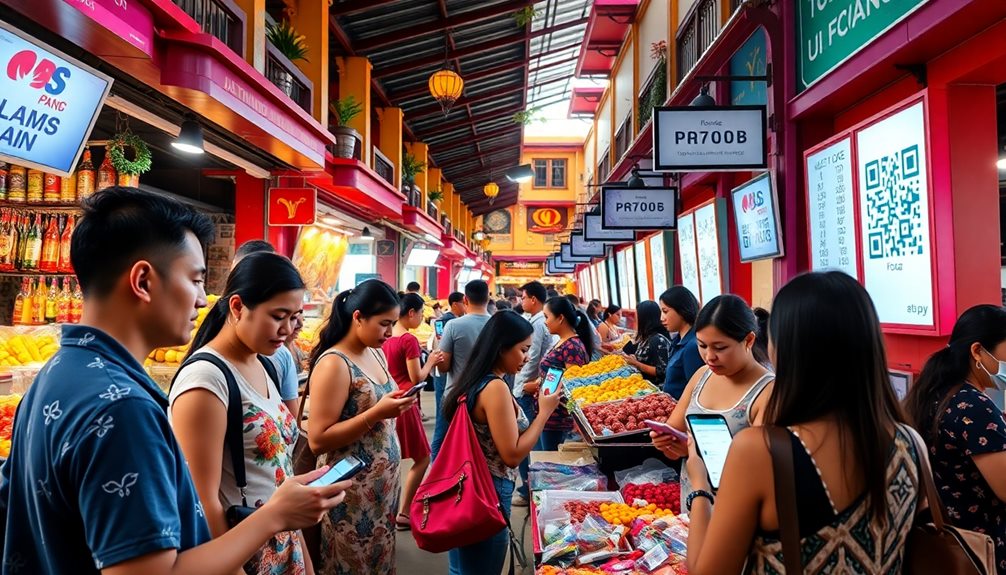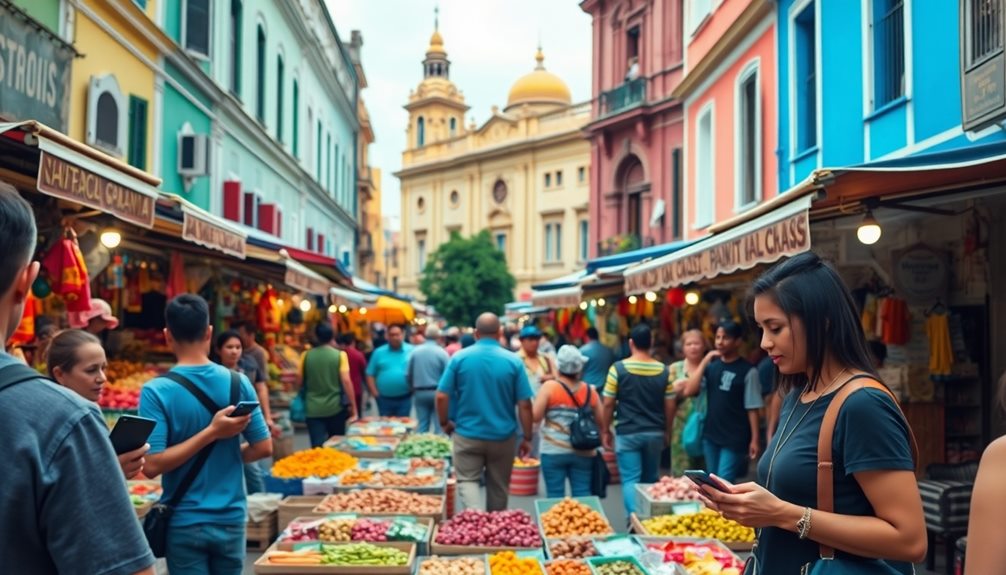Latin American digital payment systems are reshaping the financial landscape, making transactions easier and more secure for everyone. You'll notice a significant shift from cash to digital options, especially in countries like Argentina and Peru. Mobile payments are gaining traction, often facilitated by user-friendly technologies like QR codes. Central banks are essential in ensuring security and regulatory compliance, enhancing consumer trust. Despite challenges with access and outdated regulations, the trajectory shows promise. Stay tuned, and you'll discover how innovations like real-time payment systems are pushing the region toward greater financial inclusion and empowerment.
Key Takeaways
- Digital payments are rapidly gaining popularity in Latin America, with debit cards preferred over cash by Spanish-speaking consumers.
- Mobile payment adoption is surging, especially in Argentina and Peru, driven by millennials and facilitated by QR code technology.
- Central banks are crucial for ensuring secure digital payment systems and fostering partnerships with fintechs to enhance user experience.
- Financial inclusion remains a challenge, with only 73% of Latin Americans holding bank accounts, but fintech innovations are bridging these gaps.
- Fast payment systems like Brazil's Pix and Costa Rica's SINPE are revolutionizing transaction speeds and promoting economic participation across the region.
Overview of Payment Trends

In recent years, digital payment trends in Latin America have transformed dramatically, with debit cards now preferred over cash among Spanish-speaking consumers. This shift marks a notable milestone in the region's financial landscape.
Between 2021 and 2023, there's been a remarkable increase in the adoption of digital payments, signaling a move towards more modern payment methods. Enhanced security measures, akin to those used in Google Pay security measures, are essential for building consumer trust in these digital platforms.
Countries like Argentina and Peru have seen consumer preferences for non-cash options more than double, showcasing a strong inclination towards digital transactions. Payment cards, both credit and debit, now dominate online shopping, capturing over 50% of the market share in nations such as Ecuador and Panama.
Moreover, real-time payment schemes like Yape and Plin are set to expand considerably by 2024, enhancing the efficiency of transactions. This rapid digitization isn't just about convenience; it also plays a critical role in promoting financial inclusion.
As consumers embrace these changes, financial institutions must develop tailored strategies to address the diverse behaviors and preferences that arise in this evolving landscape. You can see that the future of payments in Latin America looks promising, with technology paving the way for greater accessibility and efficiency.
Mobile Payment Adoption

Mobile payments are rapidly reshaping the financial landscape in Latin America, particularly in countries like Argentina and Peru, where their popularity is surging. The ease of use and security of mobile payments drive consumer adoption, especially among millennials—17% of them prefer this method according to recent surveys.
High penetration of QR codes enhances this trend, enabling low-cost transactions without the need for complex point-of-sale systems. However, despite these positive developments, some markets face barriers. Merchant acceptance remains a critical issue in countries like the Dominican Republic, Ecuador, and Guatemala, slowing down the growth of mobile payments.
The rising demand for contactless transactions has led to over 250,000 mobile phones being activated as payment terminals, empowering small businesses to embrace digital payments. This shift not only supports merchants but also fosters greater accessibility to financial services for consumers.
| Country | Mobile Payment Adoption | Key Technology |
|---|---|---|
| Argentina | High | QR Code |
| Peru | Increasing | Contactless |
| Dominican Republic | Low | Merchant Acquirers |
Financial Inclusion Efforts

Financial inclusion efforts in Latin America have gained momentum, especially during the COVID-19 pandemic, which pushed many to open bank accounts and adopt digital financial services. By 2021, bank account ownership soared to about 73%, a significant increase from 30-50% in 2019.
This shift highlights the urgent need for improved financial inclusion compared to over 90% in developed countries. As individuals gain access to these services, understanding common financial terms becomes essential for making informed decisions. Additionally, the rise of digital finance has encouraged people to create personal budgets, enabling better management of their newfound resources.
Here are three key factors driving this change:
- Fintech Companies: These innovators are vital in providing access to essential financial services for unbanked populations, bridging the gap in financial inclusion.
- Fast Payment Systems: Initiatives like Brazil's Pix allow real-time transactions, reducing cash reliance and enabling underserved communities to participate in the economy.
- Successful Bancarization Initiatives: Programs like BancoEstado's CuentaRUT in Chile have helped 13.7 million people gain access to banking services, reaching around 70% of the population.
The rise of digital payments in Latin America is reshaping the landscape, making financial services more accessible and inclusive for all.
Innovations in Payment Systems

Latin America's payment landscape is rapidly evolving, driven by innovative technologies that enhance convenience and security for consumers and businesses alike. The rise of digital payments in Latin America has been particularly notable, with systems like Pix leading the charge. Launched in November 2020, Pix reached 100 million users within its first year, showcasing its appeal and effectiveness in real-time transactions.
This surge in digital payment adoption parallels trends observed in other markets, such as the US Commercial Security Market Outlook, where technological advancements are also transforming industries.
Another game-changer is Tap to Phone technology, which allows small businesses to accept contactless payments via smartphones. Over 250,000 mobile phones are now active as payment terminals in the region, making transactions even more accessible.
Speaking of contactless payments, the adoption rate has soared, achieving 50% penetration within just four years and reporting a 69% growth in these transactions by December 2022.
Innovations such as QR codes and request to pay features are further enhancing payment systems' functionality, driving their adoption among various consumer segments.
Additionally, the implementation of token technology has considerably improved transaction security, with over 90% of Visa payment credentials in Latin America being token-ready by September 2022.
These advancements collectively illustrate a vibrant and secure future for digital payments in the region.
Role of Central Banks

Central banks play an essential role in regulating digital payment systems, ensuring they operate securely and efficiently.
By collaborating with fintechs, they foster innovation and create a more inclusive financial landscape.
You'll see how their oversight not only enhances user experience but also builds trust in these rapidly evolving payment solutions.
Regulatory Oversight Importance
In today's rapidly evolving digital landscape, the role of central banks in regulating payment systems is more essential than ever. They guarantee secure and efficient transactions across Latin America, particularly in countries like Brazil, Bolivia, and Costa Rica.
Central banks establish regulatory frameworks that not only foster interoperability but also drive innovation in payment systems, ultimately enhancing the user experience.
Here are three key reasons why regulatory oversight is important:
- Consumer Trust: By addressing challenges such as fraud and cybersecurity, central banks maintain the integrity of payment systems, guaranteeing that users feel safe in their transactions.
- Accelerated Adoption: Empirical analysis shows that central bank involvement considerably speeds up the adoption of fast payment systems, creating a secure environment for real-time transactions.
- Broad Access: Collaboration between central banks, traditional banks, and fintech companies drives technological advancements, expanding access to financial services for more people.
As digital transformation continues to reshape the financial landscape, the central banks' role in maintaining and regulating payment systems becomes increasingly critical for fostering a stable and inclusive economy.
Collaboration With Fintechs
The collaboration between central banks and fintechs is revolutionizing the payment landscape in Latin America. Central banks, like those in Brazil and Costa Rica, are actively managing fast payment systems, showcasing how regulatory frameworks can foster innovation through partnerships with fintechs. This cooperation enhances payment solutions, making transactions smoother and more efficient for users.
| Country | Fast Payment System | Central Bank Role |
|---|---|---|
| Brazil | Pix | Regulatory oversight |
| Costa Rica | SINPE | Innovation facilitation |
| Argentina | Payment interoperability | User experience focus |
| Peru | Sistema de Pagos | Secure transaction framework |
In Argentina and Peru, regulatory actions emphasize the importance of user experience and interoperability, further highlighting the necessity of fintech collaboration. Central banks are vital for catalyzing the adoption of fast payment systems by establishing secure transaction frameworks.
The synergy between traditional banks and fintechs is essential, merging established financial practices with innovative technology. By working together, they create a better payment ecosystem that benefits consumers and businesses alike. This collaboration is not just a trend; it's shaping the future of payments in Latin America.
Challenges and Opportunities

Digital payment systems in Latin America face a mix of challenges and opportunities that greatly shape their development. While the potential for considerable growth exists, several challenges remain that need addressing.
Here are three key areas to reflect on:
- Access: Limited access to digital payment solutions is a major hurdle, with only 73% of Latin Americans owning bank accounts, compared to over 90% in developed countries. Many still rely on cash, with 70% reporting recent cash usage, highlighting the need for more inclusive financial options.
- Regulatory Frameworks: Outdated legal frameworks hinder advancements in digital payments in Latin America. Regulatory harmonization is essential to streamline payment processes, allowing businesses and consumers to benefit from improved technologies.
- Trust and Security: Cooperation between public and private sectors is critical to build trust. Fraud and cybersecurity concerns greatly impact consumer confidence, making it imperative to enhance the safety of digital payment platforms.
The PAGA initiative, launched in 2021, aims to foster collaboration among various sectors to address these challenges and facilitate economic growth, paving the way for more robust digital payment systems.
Future of Digital Payments

As you explore the future of digital payments in Latin America, you'll see emerging technologies reshaping how transactions happen.
Innovations like cryptocurrencies and mobile wallets are set to enhance financial inclusion, bringing services to those previously left out.
This evolution not only boosts convenience but also builds trust in digital payment systems across the region.
Emerging Payment Technologies
Emerging payment technologies are transforming the landscape of financial transactions in Latin America, making them faster, safer, and more accessible. As you explore the latest innovations, you'll notice several key trends shaping the future of digital payments in Latin America:
- Real-Time Payment Systems: Brazil's Pix has gained over 100 million users in just its first year, demonstrating a strong shift toward digital payment solutions.
- Contactless Payment Transactions: With a 50% penetration rate in just four years, contactless transactions surged by 69% by December 2022, showcasing the region's growing preference for convenience.
- Innovative Solutions: The Tap to Phone technology allows small businesses to accept payments via smartphones, activating over 250,000 mobile devices as payment terminals across the region.
Additionally, the PAGA initiative, launched in 2021, aims to enhance digital payment systems, addressing challenges while promoting an inclusive and secure payment environment.
With over 100 stakeholders involved, new payment technologies are paving the way for a robust digital payment ecosystem, ensuring your transactions remain seamless and secure.
Financial Inclusion Strategies
The rapid adoption of innovative payment technologies in Latin America has opened up new avenues for financial inclusion, addressing the needs of unbanked and underbanked populations. By 2021, bank account ownership rose to roughly 73%, largely due to increased digital payments in Latin America and the shift to online banking spurred by the COVID-19 pandemic.
Financial inclusion strategies like the PAGA initiative, which unites over 100 stakeholders, aim to enhance these digital payments and tackle existing challenges in the payment ecosystem.
Successful bancarization efforts, such as BancoEstado's CuentaRUT program in Chile, have provided financial services to around 70% of the population, showcasing effective strategies to integrate individuals into the financial system.
Additionally, central banks are rolling out real-time payment schemes, projected to boost A2A payment adoption across LATAM by 2027.
Public-private cooperation is essential for advancing these digital payment systems and ensuring consumer protections. As digital payments continue to grow in Latin America, these strategies will be crucial in fostering a more inclusive financial landscape, ultimately empowering millions to participate in the economy.
Frequently Asked Questions
What Is the Payment System in Latin America?
Payment systems today rely heavily on credit and debit cards for online transactions. You'll notice a growing trend toward mobile payments, digital wallets, and real-time systems, making transactions quicker and more accessible for everyone.
What Is the Best Digital Bank in Latin America?
When choosing the best digital bank in Latin America, consider factors like customer service, fees, and features. Nubank often stands out for its user-friendly app, extensive services, and impressive customer base, making it a top contender.
What Are the Alternative Payment Methods in Latam?
You'll find various alternative payment methods, like account-to-account systems and digital wallets. These options enhance transaction efficiency and convenience, making it easier for you to manage your finances and complete purchases seamlessly.
What Are Local Payment Methods in Latin America?
In Latin America, you'll find various local payment methods. Popular options include Yape, Plin, and PSE for instant transactions. Digital wallets are also thriving, while cash remains common in certain regions like Mexico.
Conclusion
As you navigate the rapidly evolving landscape of Latin American digital payment systems, you can feel the pulse of innovation and transformation. With each new app and service, a wave of financial inclusion surges forward, promising to connect millions. Yet, lurking beneath the surface are challenges that could reshape this journey. Will central banks rise to the occasion? The future is uncertain, but one thing's for sure: the next chapter in digital payments is just around the corner.









